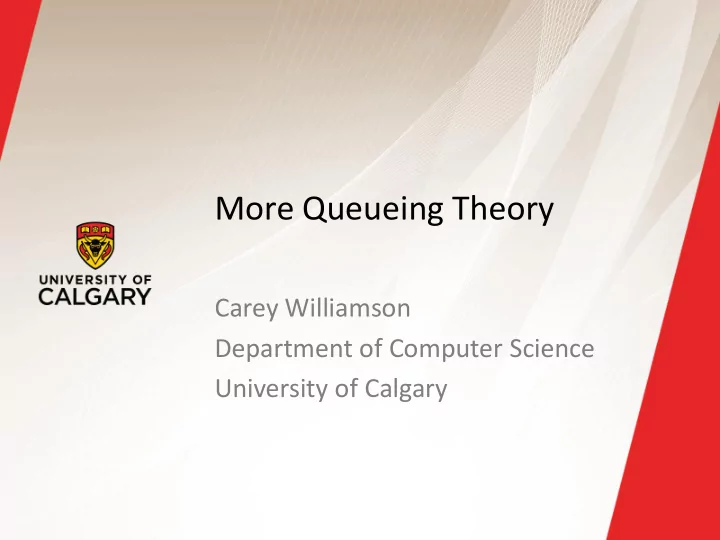

More Queueing Theory Carey Williamson Department of Computer Science University of Calgary
Motivating Quote for Queueing Models “Good things come to those who wait” - poet/writer Violet Fane, 1892 - song lyrics by Nayobe, 1984 - motto for Heinz Ketchup, USA, 1980’s - slogan for Guinness stout, UK, 1990’s 2
M/M/1 Queue ▪ M/M/1 queue is the most commonly used type of queueing model ▪ Used to model single processor systems or to model individual devices in a computer system ▪ Need to know only the mean arrival rate λ and the mean service rate μ ▪ State = number of jobs in the system l l l l l l … 0 1 2 j-1 j j+1 m m m m m m 3
Results for M/M/1 Queue (cont’d) ▪ Mean number of jobs in the system: ▪ Mean number of jobs in the queue: 4
Results for M/M/1 Queue (cont’d) ▪ Probability of n or more jobs in the system: = = − = n k P ( n k ) p ( 1 ) n = = n k n k ▪ Mean response time (using Little’s Law): — Mean number in the system = Arrival rate × Mean response time — That is: 5
M/M/1/K – Single Server, Finite Queuing Space l K K 6
Analytic Results ▪ State-transition diagram: l l l l … 0 1 K-1 K m m m m l ▪ Solution = = n p p , w here m n 0 − 1 1 + − − K 1 1 1 K = = n p = 0 n 0 1 = 1 + K 1 7
M/M/m - Multiple Servers 8
Analytic Results ▪ State-transition diagram: l l l l l l … 0 1 m-1 m m+1 2 m (m-1) m m m m m m m m ▪ Solution 1 n p n m l − n 1 0 = = n ! j p p m n 0 1 = n j 0 + p n m j 1 − 0 n m m ! m 9
M/M/ - Infinite Servers ▪ Infinite number of servers - no queueing 10
Analytic Results ▪ State-transition diagram: l l l l l l … 0 1 j-1 j j+1 m 2 m (j-1) m j m (j+1) m (j+2) m ▪ Solution 1 = n p p n 0 n ! − 1 1 = = − n p e = 0 n 0 n ! ▪ Thus the number of customers in the system follows a Poisson distribution with rate 𝜍 11
M/G/1 Queue ▪ Single-server queue with Poisson arrivals, general service time distribution, and unlimited capacity 1 𝜈 and variance 𝜏 2 ▪ Suppose service times have mean ▪ For 𝜍 < 1 , the steady-state results for 𝑁/𝐻/1 are: = l m = − / , p 1 0 + m + m 2 2 2 2 2 2 ( 1 ) ( 1 ) = + = E [ n ] , E [ n ] − − q 2 ( 1 ) 2 ( 1 ) l m + l m + 2 2 2 2 1 ( 1 / ) ( 1 / ) = + = E [ r ] , E [ w ] m − − 2 ( 1 ) 2 ( 1 ) 12
M/G/1 Queue — No simple expression for the steady-state probabilities — Mean number of customers in service: 𝜍 = 𝐹 𝑜 − 𝐹 𝑜 𝑟 — Mean number of customers in queue, 𝐹[𝑜 𝑟 ] , can be rewritten as: 𝜍 2 𝜇 2 𝜏 2 𝐹[𝑜 𝑟 ] = 2 1 − 𝜍 + 2 1 − 𝜍 ▪ If 𝜇 and 𝜈 are held constant, 𝐹[𝑜 𝑟 ] depends on the variability, 𝜏 2 , of the service times. 13
Effect of Utilization and Service Variability ▪ For almost all queues, if lines are too long, they can be reduced by decreasing server utilization ( 𝜍 ) or by decreasing the service time variability ( 𝜏 2 ) ▪ Coefficient of Variation: a measure of the variability of a distribution 𝑊𝑏𝑠 𝑌 𝐷𝑊 = 𝐹[𝑌] — The larger CV is, the more variable is the distribution relative to its expected value. ▪ Pollaczek-Khinchin (PK) mean value formula: + 2 2 ( 1 ( CV ) ) = + E [ n ] − 2 ( 1 ) 14
Effect of Utilization and Service Variability ▪ Consider 𝐹[𝑜 𝑟 ] for M/G/1 queue: + m 2 2 2 ( 1 ) = E [ n ] − q 2 ( 1 ) Mean no. of customers in queue + 2 2 1 ( CV ) = − 1 2 Same as for Adjusts the M/M/1 M/M/1 formula to account for queue a non-exponential service time Traffic Intensity ( 𝜍 ) distribution 15
Recommend
More recommend